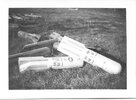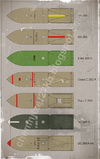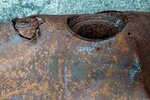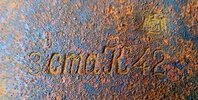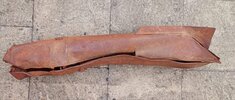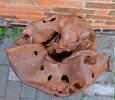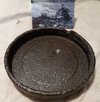As a new member of this board I thought I’d start by sharing some pictures of a container I’ve recently acquired.
This AB 23 container, was pretty corroded, distorted and dented. It was also missing the interior partitions that had rusted off and disappeared long ago.
Someone had previously attempted to bang out large dents with a small hammer, resulting in lots of small dents.
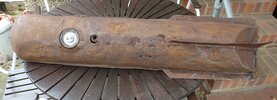
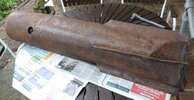
It was quickly apparent that this was never going to be suitable as a ‘concours’ restoration, but I have had a go at ‘tarting it up’ to a state where it is good enough to display.
First, I gave it a bath of Evaporust and then a coating of thick red oxide inside and out.
Spent some time in the garage sorting some of the dents and deep pits.
I have read that these containers were originally dark green on the exterior and the remnants of original green paint was still clinging on between rust pits on one of the fins.
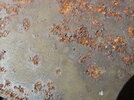
I masked this off before painting the rest, trying different shades of dark green.
Don’t know if that original paint had faded over time, but the best match seemed to be a far lighter shade of green than I’d anticipated and seemed more like ‘Feld Grau’.
I don’t normally like to re-paint wartime relics, but in this case there was only a tiny amount of original paint, which I have left in place with some clear matt lacquer hopefully keeping any further rust at bay.
The focus of my interest is wartime bomb disposal, and I occasionally exhibit related items to the public at 1940s events. I have therefore, rather conveniently, gone for a patina’d look, as if this had been found on an abandoned airfield at the end of the war during the clear up. (That way I could still get away with leaving some of the dings and pits in the casing.) I have even used some model railway, Humbrol ‘rust wash’ paint. Quite pleased with the end result -
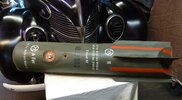
It might seem strange to restore something to a slightly distressed state, taking rust off then painting it back on, but the metal gets a covering of protective paint that should help prevent the thing from deteriorating, which it would certainly have done had it been left as it was. Guess I could have just covered the bare casing in Waxoyl, but that just leaves a rusty looking sticky mess that gets on everything it touches.
As the back would not normally be on seen when displayed, I spent less time trying to lose the dings, and hence a bit more of the faux rust finish.
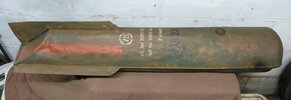
The container came with an impact fuze, which is obviously wrong, so I have put a No9 fuze in, which I know is also wrong, but it will do until I track down the correct 79 fuze.
Also looking for a lifting lug if anyone has any leads on these.
Made up some stencils with best matching fonts to original script as I could find.
I know AB stands for Abwurf Behaelter, (throw down container), and SD stands for Sprengbombe Dickwandig, (Explosive bomb thick-walled), 2 being Butterfly bombs, but I don’t know what all the white stencilling means. (I took details of these stencils off the net, as few original photos show the full markings).
I’m guessing they may have something to do with the altitude required to drop it in order for it to open and scatter properly?
If anyone can enlighten me as to what the white writing actually means, I’d appreciate it!
In my collection I already have ‘half’ of a German bomb container, - not dark green, but apparently originally painted in a buff(?) colour.
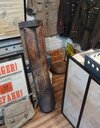
This new acquisition however, for all its issues, I think is much better for use in any future public exhibitions I may put on, alongside some of my other SD2 relics.
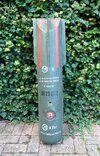
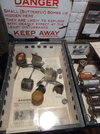
This AB 23 container, was pretty corroded, distorted and dented. It was also missing the interior partitions that had rusted off and disappeared long ago.
Someone had previously attempted to bang out large dents with a small hammer, resulting in lots of small dents.


It was quickly apparent that this was never going to be suitable as a ‘concours’ restoration, but I have had a go at ‘tarting it up’ to a state where it is good enough to display.
First, I gave it a bath of Evaporust and then a coating of thick red oxide inside and out.
Spent some time in the garage sorting some of the dents and deep pits.
I have read that these containers were originally dark green on the exterior and the remnants of original green paint was still clinging on between rust pits on one of the fins.

I masked this off before painting the rest, trying different shades of dark green.
Don’t know if that original paint had faded over time, but the best match seemed to be a far lighter shade of green than I’d anticipated and seemed more like ‘Feld Grau’.
I don’t normally like to re-paint wartime relics, but in this case there was only a tiny amount of original paint, which I have left in place with some clear matt lacquer hopefully keeping any further rust at bay.
The focus of my interest is wartime bomb disposal, and I occasionally exhibit related items to the public at 1940s events. I have therefore, rather conveniently, gone for a patina’d look, as if this had been found on an abandoned airfield at the end of the war during the clear up. (That way I could still get away with leaving some of the dings and pits in the casing.) I have even used some model railway, Humbrol ‘rust wash’ paint. Quite pleased with the end result -

It might seem strange to restore something to a slightly distressed state, taking rust off then painting it back on, but the metal gets a covering of protective paint that should help prevent the thing from deteriorating, which it would certainly have done had it been left as it was. Guess I could have just covered the bare casing in Waxoyl, but that just leaves a rusty looking sticky mess that gets on everything it touches.
As the back would not normally be on seen when displayed, I spent less time trying to lose the dings, and hence a bit more of the faux rust finish.

The container came with an impact fuze, which is obviously wrong, so I have put a No9 fuze in, which I know is also wrong, but it will do until I track down the correct 79 fuze.
Also looking for a lifting lug if anyone has any leads on these.
Made up some stencils with best matching fonts to original script as I could find.
I know AB stands for Abwurf Behaelter, (throw down container), and SD stands for Sprengbombe Dickwandig, (Explosive bomb thick-walled), 2 being Butterfly bombs, but I don’t know what all the white stencilling means. (I took details of these stencils off the net, as few original photos show the full markings).
I’m guessing they may have something to do with the altitude required to drop it in order for it to open and scatter properly?
If anyone can enlighten me as to what the white writing actually means, I’d appreciate it!
In my collection I already have ‘half’ of a German bomb container, - not dark green, but apparently originally painted in a buff(?) colour.

This new acquisition however, for all its issues, I think is much better for use in any future public exhibitions I may put on, alongside some of my other SD2 relics.



